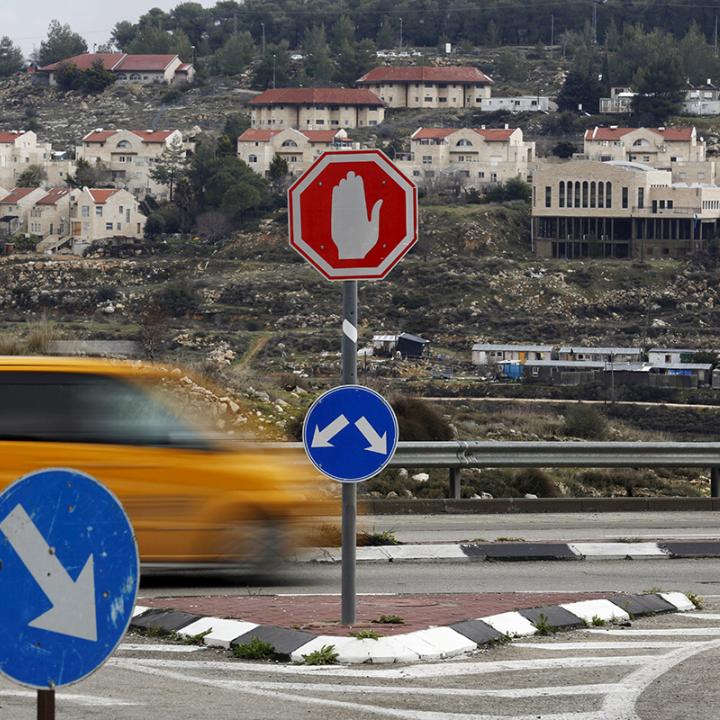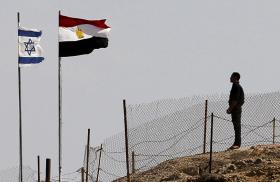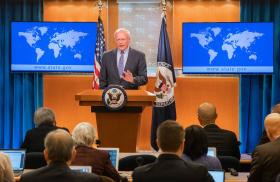
- Policy Analysis
- PolicyWatch 4083
Israel’s West Bank “Pincer” Is Squeezing the Palestinians

Israel’s conduct toward the West Bank—which has lately operated top-down and bottom-up like a pincer—could wind up triggering wider outbreaks of violence, preventing expansion of the Abraham Accords, and undermining Jerusalem's traditional bases of support internationally.
Although international attention has largely focused on the Gaza Strip since the October 7 attack on Israel, tensions have also been rising in the West Bank during this period, with 977 Palestinians killed by the Israel Defense Forces (IDF) or Jewish settlers as of late May 2025. At the same time, 66 Israelis have been killed as a result of terrorist attacks.
As described in a previous PolicyWatch, Israeli’s West Bank activity is partly a response to Palestinian terrorist attacks (most recently a July 10 attack in which two policemen recruited by Hamas killed an Israeli civilian at the Gush Etzion junction), but it is also increasingly an effort by far-right Israeli government ministers or Jewish settlers to change the geographic and demographic situation, thereby creating more favorable conditions for their vision of a “greater Israel” that includes de facto annexation of the West Bank. These motivations are clearly reflected in Israel’s Operation Iron Wall, which aims to dismantle terrorist infrastructure in northern West Bank refugee camps but has simultaneously caused extensive physical destruction and displacement of residents—an approach that aligns with the government’s stated policy of preventing the perpetuation of the Palestinian refugee issue.
Expanding Settlements in Area C
Israel’s current West Bank policy is primarily driven by Finance Minister Bezalel Smotrich, who also heads the Civil Administration—the Defense Ministry branch responsible for overseeing the West Bank. This policy is mainly aimed at expanding Jewish settlement in Area C, the territory’s open areas that are under Israeli civilian and military control and located largely outside existing settlement blocs. This is intended to prevent their future annexation to a Palestinian state and thwart any practical possibility of its establishment by preventing territorial contiguity.
To this end, the Civil Administration has planned discussions for early August regarding the approval of more than 3,400 housing units in E1, the area located between Jerusalem and Jericho that is seen as the only viable land bridge between the West Bank’s southern Palestinian urban centers (Bethlehem and Hebron) and those in the center and north (Ramallah and Nablus). (See here for maps, demographic data, access routes, and other information about E1 and surrounding areas.) For years, Israel has frozen plans to build in E1 due to international pressure, including from Washington, but Smotrich has stated that moving forward now will help “kill the Palestinian state” and promote the goal of reaching one million Jewish settlers in the West Bank. In May, the cabinet decided to establish twenty-two settlements in E1; nine completely new ones and thirteen formed by legalizing existing outposts. This would bring the number of new settlements approved since October 2023 to forty-nine—seven times the average in previous decades.
The bulk of the proposed new settlements are deep inside Palestinian areas, giving the anarchic far-right activists known as “Hilltop Youth” greater access for their attacks. Most of these youths are third-generation residents of the West Bank and therefore see themselves as native to the area. From time to time, they are joined by far-right youths from Israel, mainly to take revenge on Palestinians following terrorist attacks. From January to June 2025, extremist settlers carried out 440 attacks, compared to 317 in the same period last year.
Importantly, the cabinet’s proposal would also place a significant burden on the IDF, particularly the reserve forces. Twenty-one IDF battalions are already deployed in the West Bank, more than half of them reserve battalions. Establishing new settlements and expanding existing ones would stretch their resources and extend their service, most likely at the expense of preparedness on other fronts.
The "Pincer" Is Tightening
This (partly coordinated) combination of “top-down” settlement expansion decisions and “bottom-up” settler actions has resulted in a pincer approach that is increasingly pressuring the West Bank’s Palestinian population. The cumulative effect—if not primary intent—of this pincer is to displace Palestinians from Area C, particularly farmers in small villages and semi-nomadic Bedouin herders. According to the Israeli human rights organization B’Tselem, settlement activity and settler violence in Area C have displaced dozens of Palestinian farming and herding communities since October 2023. And in recent months, this displacement has even stretched to the fringes of large Palestinian rural areas in Area B.
The government supports the Hilltop Youth by funding security, agriculture, educational, and rehabilitative activities in West Bank “farms”—which are in fact settler outposts that are called “grazing farms” to justify their broad geographic spread. According to data from Peace Now, there were 270 outposts in the West Bank as of May, about half of them designated as farms. Of these, 112 had been established since early 2023, after the formation of the current government. Former security officials indicate that hundreds of millions of shekels have been allocated for these outposts.
The far right in Israel—including think tanks, NGOs, and affiliated media—justify this policy by citing the need to thwart the “Fayyad Plan,” conceived in 2009 by then-Palestinian Authority Prime Minister Salam Fayyad, which aimed to create conditions for Palestinian statehood and control over Area C. Today, the PA is attempting to implement that plan by registering Palestinian land ownership rights in these areas, and the European Union is funding infrastructure for Palestinian communities there.
Over the past two weeks, the West Bank has drawn more international attention due to a pair of violent incidents that sparked harsh criticism against Israel, even from its staunch supporters. The first was the July 10 killing of American citizen Saifullah Musallet in the village of Sinjil, between Ramallah and Nablus, during a clash between Palestinian residents and nearby Israeli settlers in which a local Palestinian youth was shot dead. U.S. Ambassador Mike Huckabee demanded a thorough investigation into the circumstances of Musallet’s death, though no suspects have yet been arrested.
The second incident was a reported arson attack on the remains of a Byzantine church in the Palestinian Christian village of Taybeh, east of Ramallah. On July 14, the Catholic and Orthodox patriarchs of Jerusalem visited the village and accused the Israeli government of backing violent Jewish settlers. According to the Israeli police, the church was not set on fire, but the incident remains suspicious in light of ongoing friction between Palestinian residents of the village and settlers in the nearby outpost.
Relations have also grown tense between the Hilltop Youth and Israeli security forces, especially the IDF. On June 25, dozens of these youths attempted to carry out an arson attack in a Palestinian village north of Ramallah. When IDF personnel stopped them, they threatened the soldiers and attempted to damage military equipment. Six were detained for questioning but later released, raising doubts about the state’s willingness to seriously address settler violence even when directed at its own forces. Since October 7, extremists in the West Bank have carried out about 100 attacks against Israeli military personnel.
The perception that the government takes a lenient approach to Jewish violence in the West Bank was bolstered in November 2024, when Defense Minister Israel Katz announced that he would no longer issue administrative detention orders against settlers there. This not only lends support to accusations that Israel’s policy toward West Bank Palestinians is discriminatory, but also encourages violence by the Hilltop Youth and sends a message to the security services to take a lenient approach.
Where Are the Police?
The Israeli police have limited powers in the West Bank and are unable to effectively confront violence by extremist Israelis. Furthermore, the police make little effort to enforce the law against settlers or far-right activists due to policies and directives from higher up, most notably from National Security Minister Itamar Ben-Gvir. This combination of institutional weakness and political direction creates a lawless environment in which radical youths act as the de facto rulers of the territory.
Former Israel Security Agency head Ronen Bar has warned that since Ben-Gvir assumed his current post, the police, as a matter of policy, have failed to address Jewish terrorism in the West Bank and may even be tacitly supporting it. According to Israeli media reports from May, Bar complained to Prime Minister Binyamin Netanyahu that his policy on approving wiretaps on Jews suspected of crimes against Palestinians and terrorist activities is much more restrictive than in the past.
Policy Implications
Israeli-Palestinian tensions in the West Bank are intensifying even as the Gaza war continues. If a ceasefire is reached in Gaza, it may spur violent radicals on both sides to shift their attention to the West Bank—a territory whose geographic, demographic, and historical characteristics could make the outbreak of wide-scale violence even more harmful to regional and international stability than the violence in Gaza. To stop this escalation, the following steps are required.
The Israeli government must adopt a more resolute policy against West Bank settler violence, and demonstrate this policy through its intelligence activities, investigations, indictments, and other actions. Jewish terrorism against Palestinians or foreign civilians intensifies the cycle of violence, provokes international criticism, and further erodes support from broad sectors of the global public that are vital to Israel.
The government must also avoid or reverse steps that are perceived or openly intended as blocking any possibility of a future “political horizon.” These steps fuel the anger and despair that encourage terrorism and weaken the PA security apparatus responsible for thwarting it. Earlier this week, for example, the Knesset approved a declaration to apply sovereignty over the West Bank and Jordan Valley. Although this is a symbolic move with no immediate legal implications, it has generated discontent among Arab states and could undermine regional stability.
In Washington, if the Trump administration seeks to expand the Abraham Accords following a ceasefire in Gaza, it cannot afford to ignore the West Bank. The Israeli government’s settlement policy risks undermining key American interests in the region. Significant settlement expansion, especially in sensitive areas like E1, is not merely a theoretical obstacle to the two-state solution, but also a concrete threat to continuing the normalization process. With Arab states closely watching Israel’s conduct toward the Palestinians, such actions could provoke negative reactions from current partners and block progress with new ones.
For their part, regional actors must make clear to the PA that its actions to thwart Palestinian violence are a key test of its credibility. This applies not only to its status as a partner to future political agreements, but also to its potential role in postwar Gaza—whether it is given direct control of the Strip or asked to provide legitimacy to a local governing body that has broad regional and international support.
Neomi Neumann is an adjunct fellow with The Washington Institute and former head of the research unit at the Israel Security Agency.


